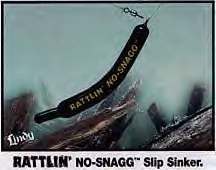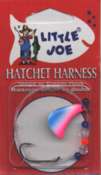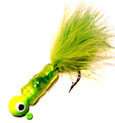

















Click on the image to vote for this site.

Want to join The Top 1000 Fishing Sites, click here!
Want to view the list, click here!

|
Heat Wave a Comin’
By Sam Anderson
Nothing on earth that’ll get me humin’ like a heat wave comin’;
Yes sir, Clint Black is right when he sings his song Summer’s Comin’.
A lot of us started out singing that song in April. However, in many
parts of the North we were still singing Summer’s Comin’ into September.
Due to the cool spring and summer, we as anglers have to realize that
the fish are going to be in a different pattern than they were last year
at this time.
Walleyes are found around structure. In any lake, river or reservoir,
most walleyes hang around certain significant bottom shapes. Deep
water reefs ( sunken islands) are a classic example, as are points that
extend into water deep enough to suit walleyes.
The key to consistent success is finding the fish, not using a magic
lure or bait. During the summer and especially during the heat of
the day, deep water humps or sunken islands are the most important structure
for locating walleyes.
Most structure that attracts walleyes will have a significant drop
off, giving the fish an easy way to move up and down in the water while
staying close to the bottom. Light penetration and water temperature
usually determine how deep they will be. Walleyes like water temperatures
in the 60s. Therefore, I would expect to find walleyes along steeply
dropping structure over a hard bottom, deep enough to escape bright light
and deep enough to be in water in the mid to high 60s.
Using your electronics to locate prime structure and deep water fish
is a good idea, as is using several markers to define the structure outlining
each break. Markers should be dropped at least 10 feet away from
any fish you’ve marked. If a good location can be pinpointed by using
landmarks or a plotter screen on my locator, I will not use markers making
my new found hotspot less obvious to fishing pressure. A fisherman’s
underwater eyes are his electronics, and the correct interpretation of
their readings is what finding those walleyes is all about. Knowing
the habits of various species is also vital. Shad, for example, generally
appear as a large mass, and walleyes usually appear as a group of individual
makes related to the structure. Knowing which bottom types hold fish,
and how to find them, is also extremely important. If a second echo
appears on your sonar screen, for example, a hard bottom is directly below
the boat. If the double echo disappears completely, the bottom is
most likely soft. Walleyes usually prefer harder bottoms.
I’ve discoverd that walleyes on deep water humps or submerged reefs
are
usually easier to find and catch then shallow water fish. I’ve
caught some large walleyes fishing these submerged humps in 35 feet of
water. By in large, hot weather patterns include brushpiles or weeds on
humps in 15 to 20 feet of water, and creek channels lying at the same depth.
Inside turns on these humps or boulder edges are also prime locations.
The best way to fish these underwater structures is with a live bait presentation.  Live bait rigs, the most famous and typical of which is the Lindy Rig,
usually involve a snelled hook on a light monofilament
Live bait rigs, the most famous and typical of which is the Lindy Rig,
usually involve a snelled hook on a light monofilament
leader. Using a Lindy No Snagg weight attached to your line and
tying on the leader end of the Lindy Rig to your line will give you a natural
presentation that will keep your offering out of the rocks and enticing
to the walleyes. Live bait rigs can be varied in many ways. Light
sinkers are used for shallow water; heavier sinkers are needed in deeper
water. Sometimes spinners, like the Hatchet Harness, are added just above the
hook for added attraction. To get the bait up off the bottom a little
more some trollers have gone to floating jig heads with bottom bouncers.
While live bait rigging is an efficient way of locating a school of walleyes,
most anglers would rather jig for them. It’s just more fun, and tends
to produce more large fish. Jig fishing is relatively inefficient
unless you know where the fish are; if you’ve got a school
Sometimes spinners, like the Hatchet Harness, are added just above the
hook for added attraction. To get the bait up off the bottom a little
more some trollers have gone to floating jig heads with bottom bouncers.
While live bait rigging is an efficient way of locating a school of walleyes,
most anglers would rather jig for them. It’s just more fun, and tends
to produce more large fish. Jig fishing is relatively inefficient
unless you know where the fish are; if you’ve got a school
located, however, jigging is deadly. Jigging works better than
live bait rigging for walleyes in shallow water, for walleyes holding tight
to structure, and for walleyes in weedy cover. Most of the time, the best
jig is one tipped with live bait, such as a minnow. Leeches and crawlers
are also used, though less often. The jig that I prefer is the soft
bodied Lindy Fuzz-E-Grub. The reason,  I prefer it is that it adds bulk and slows down the rate of fall through
the fishing column. Many times the fish will hit it on the fall and
the slower the presentation the chances of a good strike are improved.
Many lakes and rivers across the country are crowded during the heat wave
that is a coming, and fishing deep hump structure is one way to avoid the
pressure. You’ll also catch more walleyes if you can remember… "Nothing
on earth that’ll get me humin’ like a heat wave comin’ I’ll come runin’
with a makin’ that tan in the broad daylight every night is Saturday night,
and everything right with the summer comin’… I’m the first one standing
in line."
I prefer it is that it adds bulk and slows down the rate of fall through
the fishing column. Many times the fish will hit it on the fall and
the slower the presentation the chances of a good strike are improved.
Many lakes and rivers across the country are crowded during the heat wave
that is a coming, and fishing deep hump structure is one way to avoid the
pressure. You’ll also catch more walleyes if you can remember… "Nothing
on earth that’ll get me humin’ like a heat wave comin’ I’ll come runin’
with a makin’ that tan in the broad daylight every night is Saturday night,
and everything right with the summer comin’… I’m the first one standing
in line."
Let me know how you are doing during the "heat wave" and through the
nearing of fall. You’ll find me on the web at:www.samanderson.com.
and we can talk about your success.

Walleyes Inc. website is maintained
by Randy
Tyler Fishing the In-Fisherman Professional Walleye Circuit, Masters
Walleye Circuit and the Team Walleye Circuit. All rights reserved.Copyright
1999/2000
Please visit these site sponsors
Daiichi/Tru-Turn Hooks,
Lindy
Little Joe,
R-A.M Mounting Systems,
Ranger
boats,
Mercury Marine, Bedford
Sales and Hamby's Beaching Bumpers,
Goldeneye Marine products, Panther
Marine Products
|



